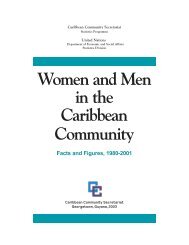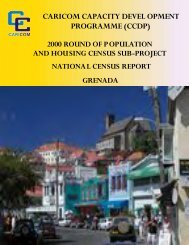CARICOM CAPACITY DEVELOPMENT PROGRAMME (CCDP)
CARICOM CAPACITY DEVELOPMENT PROGRAMME (CCDP)
CARICOM CAPACITY DEVELOPMENT PROGRAMME (CCDP)
Create successful ePaper yourself
Turn your PDF publications into a flip-book with our unique Google optimized e-Paper software.
National Census Report 2001, St. Vincent and the Grenadineslived in households where the head was also a youths (between ages 15 and 24), while theremaining 12.47 per cent lived with an elderly head of household (Table 9.3). The percentage ofyouth that lived with a youth head of household was even higher among the older youths (19.23per cent) compared to the younger youths (6.83 per cent).Overall, youths were more likely to have lived with a male head of household who is in the 45 to64 years age group with 43.18 per cent of the youth population living with a male head ofhousehold in this age group. Among youths living with a female head however, majority livedwith a head in the 25-44 years age group (41.12 per cent), (Table 9.3)9.4 Economic Activity of YouthsIn 2001, 31.55 per cent of the youths worked. The rate of employment was even higher amongolder youths (48.90 per cent) compared to the younger youths (16.63 per cent). A comparison bysex shows that employment was highest among male youths in the 20 to 24 years age group thanmale youths in the 15-19 years age group (58.03 per cent compared with 23.11 per cent). Amongfemales there was a similar pattern with percentages of 39.30 compared with 10.07. The overallemployment for male youths was 39.42 per cent compared to 23.45 per cent for the femaleyouths, (Tables 9.4 to 9.6).The majority of the working youths had primary (44.08 per cent) or secondary (40.84 per cent)level education, while 11.95 per cent had pre-university, and less than one per cent had auniversity degree. As expected, the older working youths 20 to 24 years were more likely thanthose 15 to 19 years to have had a pre-university or university degree, 15.46 compared to 5.65per cent.The majority of the working male youths had a secondary (33.57 per cent) or primary education(56.52 per cent) and 7.17 per cent had pre-university. The corresponding rates for the workingfemale youths are, 53.42 with secondary, 22.55 with primary and 20.24 per cent with preuniversity.These figures indicate that although employment was higher among male comparedto female youths, the working female youths were better educated. The majority of them had a114










